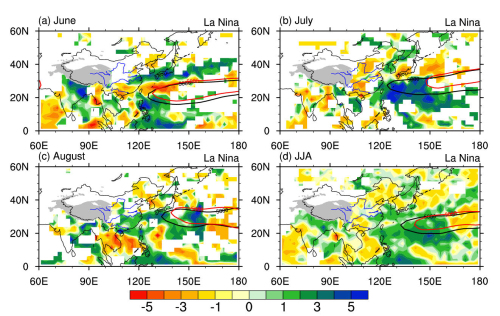Intraseasonal variation of the East Asian summer monsoon in La Nina years
Date:2017-02-21
Based on multi-year reanalysis data, Prof. XUE Feng from Institute of Atmospheric Physics and his student ZHAO Jun-Jie studied the intraseasonal variation of the EASM and summer rainfall over East Asia in La Ni?a years (Xue and Zhao, 2017). They find that owing to a higher SST over the western Pacific warm pool in the preceding winter and spring, warm pool convection in summer is enhanced. As a result, the WPSH extends more northeastward. This anomalous pattern tends to change with the march of the seasons, with a maximum anomaly in July (Figure 1). The rainfall distribution in East Asia in La Ni?a summers is characterized by a zonal pattern of less rainfall over eastern China and more rainfall over the oceanic region of the western Pacific. By comparison, a meridional pattern is found in El Ni?o summers, with less rainfall over the tropics and more rainfall over the subtropics and midlatitudes.

Figure 1. Rainfall anomaly in La Ni?a years (units: mm d?1) and the 500 hPa western Pacific subtropical high (units: gpm). Regions with statistically significant results at the greater than 95% confidence level are shaded. The black and red contours represent the WPSH in La Ni?a years and the climatological mean, respectively. (Xue and Zhao, 2017)
They also find that owing to an earlier eastward retreat of the WPSH in La Ni?a summers, the seasonal march in East Asia is accelerated, with an earlier onset and termination of the mei-yu season and less rainfall over the Yangtze River basin. Therefore, a La Ni?a signal is useful for mei-yu prediction. By contrast, the maximum anomaly in El Ni?o summers is found in August.
"Except in some strong El Ni?o years, an El Ni?o signal is of little use to mei-yu prediction, although El Ni?o signals are statistically stronger than La Ni?a signals." Prof. XUE observed, "The influence of La Ni?a is not anti-symmetric to that of El Ni?o."
References
Xue, F., and J. J. Zhao, 2017. “Intraseasonal variation of the East Asian summer monsoon in La Ni?a years.” Atmospheric and Oceanic Sciences Letters 10: 156–161.
Xue, F., and C. Z. Liu, 2008. “The influence of moderate ENSO on summer rainfall in eastern China and its comparison with strong ENSO.” Chinese Science Bulletin 53: 791–800.
Zhao, J. J., F. Xue, W. T. Lin and A. M., Duan, 2016. The influence of El Ni?o on the intraseasonal variation of East Asian summer monsoon and summer rainfall. Climatic and Environmental Res. 21: 678–686 (in Chinese).
